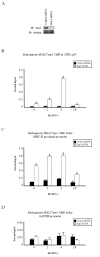Roles for common MLL/COMPASS subunits and the 19S proteasome in regulating CIITA pIV and MHC class II gene expression and promoter methylation
- PMID: 20181089
- PMCID: PMC2829561
- DOI: 10.1186/1756-8935-3-5
Roles for common MLL/COMPASS subunits and the 19S proteasome in regulating CIITA pIV and MHC class II gene expression and promoter methylation
Abstract
Background: Studies indicate that the 19S proteasome contributes to chromatin reorganization, independent of the role the proteasome plays in protein degradation. We have previously shown that components of the 19S proteasome are crucial for regulating inducible histone activation events in mammalian cells. The 19S ATPase Sug1 binds to histone-remodeling enzymes, and in the absence of Sug1, a subset of activating epigenetic modifications including histone H3 acetylation, H3 lysine 4 trimethylation and H3 arginine 17 dimethylation are inhibited at cytokine-inducible major histocompatibilty complex (MHC)-II and class II transactivator (CIITA) promoters, implicating Sug1 in events required to initiate mammalian transcription.
Results: Our previous studies indicate that H3 lysine 4 trimethylation at cytokine-inducible MHC-II and CIITA promoters is dependent on proteolytic-independent functions of 19S ATPases. In this report, we show that multiple common subunits of the mixed lineage leukemia (MLL)/complex of proteins associated with Set I (COMPASS) complexes bind to the inducible MHC-II and CIITA promoters; that overexpressing a single common MLL/COMPASS subunit significantly enhances promoter activity and MHC-II HLA-DRA expression; and that these common subunits are important for H3 lysine 4 trimethylation at MHC-II and CIITA promoters. In addition, we show that H3 lysine 27 trimethylation, which is inversely correlated with H3 lysine 4 trimethylation, is significantly elevated in the presence of diminished 19S ATPase Sug1.
Conclusion: Taken together, these experiments suggest that the 19S proteasome plays a crucial role in the initial reorganization of events enabling the relaxation of the repressive chromatin structure surrounding inducible promoters.
Figures






Similar articles
-
The 19S proteasome positively regulates histone methylation at cytokine inducible genes.Biochim Biophys Acta. 2009 Nov-Dec;1789(11-12):691-701. doi: 10.1016/j.bbagrm.2009.07.006. Epub 2009 Aug 3. Biochim Biophys Acta. 2009. PMID: 19660582
-
The 19S proteasome ATPase Sug1 plays a critical role in regulating MHC class II transcription.Mol Immunol. 2008 Apr;45(8):2214-24. doi: 10.1016/j.molimm.2007.12.001. Epub 2008 Jan 22. Mol Immunol. 2008. PMID: 18215421
-
The 19S ATPase S6a (S6'/TBP1) regulates the transcription initiation of class II transactivator.J Mol Biol. 2010 Jan 15;395(2):254-69. doi: 10.1016/j.jmb.2009.10.035. Epub 2009 Oct 21. J Mol Biol. 2010. PMID: 19853614
-
Regulation of acetylation at the major histocompatibility complex class II proximal promoter by the 19S proteasomal ATPase Sug1.Mol Cell Biol. 2008 Oct;28(19):5837-50. doi: 10.1128/MCB.00535-08. Epub 2008 Jul 28. Mol Cell Biol. 2008. PMID: 18662994 Free PMC article.
-
Epigenetic regulation of MHC-II and CIITA genes.Trends Immunol. 2006 Sep;27(9):405-12. doi: 10.1016/j.it.2006.07.007. Epub 2006 Jul 25. Trends Immunol. 2006. PMID: 16870508 Review.
Cited by
-
Multiple histone methyl and acetyltransferase complex components bind the HLA-DRA gene.PLoS One. 2012;7(5):e37554. doi: 10.1371/journal.pone.0037554. Epub 2012 May 31. PLoS One. 2012. PMID: 22701520 Free PMC article.
-
Expression regulation of major histocompatibility complex class I and class II encoding genes.Front Immunol. 2011 Oct 4;2:48. doi: 10.3389/fimmu.2011.00048. eCollection 2011. Front Immunol. 2011. PMID: 22566838 Free PMC article.
-
Ubiquitin and proteasomes in transcription.Annu Rev Biochem. 2012;81:177-201. doi: 10.1146/annurev-biochem-052110-120012. Epub 2012 Mar 8. Annu Rev Biochem. 2012. PMID: 22404630 Free PMC article. Review.
-
Cks1 enhances transcription efficiency at the GAL1 locus by linking the Paf1 complex to the 19S proteasome.Eukaryot Cell. 2013 Sep;12(9):1192-201. doi: 10.1128/EC.00151-13. Epub 2013 Jul 3. Eukaryot Cell. 2013. PMID: 23825181 Free PMC article.
-
H3K4 trimethylation regulates cancer immunity: a promising therapeutic target in combination with immunotherapy.J Immunother Cancer. 2023 Aug;11(8):e005693. doi: 10.1136/jitc-2022-005693. J Immunother Cancer. 2023. PMID: 37553181 Free PMC article. Review.
References
LinkOut - more resources
Full Text Sources
Research Materials
Miscellaneous

